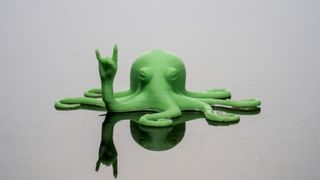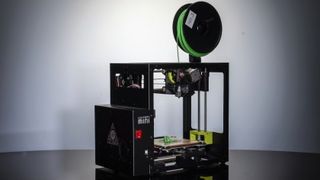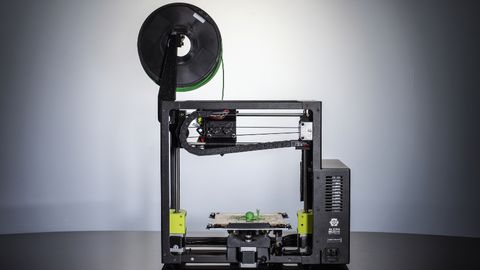Why you can trust TechRadar
Getting started
When removing the Mini from the box you're instantly struck by the attention to detail, as hidden beneath the top metal structure is a printed 3D grip which just makes lifting and moving the printer easy. Like a car jack point this grip highlights where the printer can be lifted safely which seems sensible for a machine that is extremely complex and potentially easily damaged.
Packaging and octopus removed (like cereal there's one in every packet, printed for your printer to check that it leaves the factory in full working order) it's just a case of plugging into the mains, tethering to a computer and you're almost ready to go. There are a couple of setup procedures, such as loading the Cura software, removing a short length of filament from the head and loading your own filament, but all this only takes a few minutes.

Lulzbot recommend that the first print you try is the Rocktopus which is a freely downloadable file from its website – once it's downloaded you can then tweet your first 3D printed effort to the Lulzbot gallery. Again this reinforces the community feel that owning this printer instantly gives you. In the box alongside the printer is an easy to follow quick start guide along with a series of tools and some glue for the print base to help you get started. These tools also help you to maintain the printer in the future, a touch unmatched by other manufacturers.
Printing
The unboxing to print time is around twenty minutes depending on how focused you are and how long it takes you to download and install the Cura Lulzbot edition software. Once hardware and software are in place and connected by USB, the Cura software then needs to be configured. This is easy enough with a click-through setup process and decent set of instructions that quickly gets you to the point where you're ready to start printing.
As mentioned, it's suggested that you download and print the Rocktopus model for your first print and to test that the printer is working correctly. With the model loaded into Cura all you need to do is hit connect and then print. A whirl of the fan and a few minutes later the machine comes alive. This initial print takes around 50 minutes using the default settings, with a great result first time showing that everything was working as it should be. Once the Rocktopus is finished the knife included with the printer can be used to prize the model from the heated base. It's worth leaving everything to cool down for 10 minutes so the extraction of the model is easier.

The Lulzbot Mini takes 3mm filament and in our testing we used PLA, ABS and HIPS which is the preferred material. Prints using all three types of plastic turned out well using a variety of settings. A nice touch in the software is the ability to have direct access to fine adjustment of the hot-end and print base temperature, as this can greatly affect the print quality and varies with each model.
Overall print quality was good with resolutions ranging from low, at 500 microns, to a respectful 50 microns (a micron being 0.001mm so this means a maximum resolution of 0.05mm layer height). Adjusting the settings improved the quality of the prints significantly and as always a little experimentation with the settings depending on the model being produced ensured that a good print is never too far away when using the Lulzbot Mini.
When comparing the quality of a print from the Lulzbot Mini with one from the Ultimaker Go you can see a difference in the fine detail of the print showing that the Ultimaker Go just has the edge. But the Ultimaker lacks versatility when it comes to supported materials and adjustment compared to the Lulzbot.

Cura is maintained by Ultimaker and for getting started is an excellent piece of visual software that enables you to quickly switch between quick and expert settings. To help you get started there are a variety of profiles that are directly downloadable from the Lulzbot website for different materials and qualities. These can be quickly loaded depending on your filament choice and the quality of print that you want.
If however you wish to use another piece of software to control your 3D printer then the Mini also has profiles ready to download for other common applications such as Slicer.

